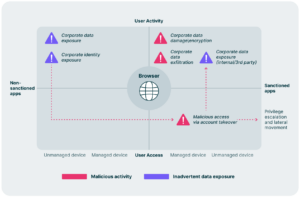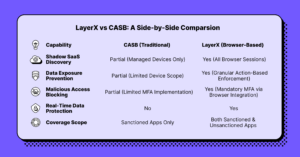The rapid adoption of Software-as-a-Service (SaaS) applications has fundamentally transformed the enterprise landscape. With organizations now utilizing an average of 371 SaaS apps—a 32% increase since 2021—these tools have become indispensable for streamlining workflows and enhancing productivity. However, this surge in SaaS usage has also introduced a complex web of security risks, ranging from data exposure to account takeovers. Traditional Cloud Access Security Broker (CASB) solutions, once the cornerstone of SaaS governance, are struggling to keep pace with these evolving threats. Enter LayerX: a browser-based approach that redefines SaaS security by addressing the inherent blind spots of legacy solutions.
The SaaS Security Landscape: Sanctioned vs. Shadow Apps
SaaS applications fall into two categories:
- Sanctioned Apps: Approved and managed by IT or security teams, these apps store corporate data and are typically accessed via Single Sign-On (SSO) solutions.
- Non-Sanctioned Apps (Shadow SaaS): Used without IT approval, these apps often fly under the radar, exposing organizations to risks like data leaks and credential theft.
Both categories present unique challenges. While sanctioned apps are vulnerable to malicious access and privilege escalation, shadow apps pose risks of inadvertent data exposure and credential misuse. The complexity of managing these risks across sanctioned and unsanctioned apps underscores the need for a more comprehensive security solution.
Why Traditional CASB Solutions Fall Short
CASB solutions rely on three core architectures—forward proxy, reverse proxy, and API access—to secure SaaS environments. While each has its merits, they collectively fail to provide real-time visibility and granular control over user activities:
- Forward Proxy: Limited to traffic originating from managed devices, leaving unmanaged devices unprotected.
- Reverse Proxy: Effective for sanctioned apps but unable to address shadow SaaS.
- API Access: Offers retroactive visibility but lacks real-time enforcement capabilities.
These limitations create critical blind spots, particularly in scenarios involving unmanaged devices or unsanctioned apps. The inability to monitor user activity within apps or enforce policies in real time leaves organizations exposed to significant risks.
The Paradigm Shift: Leveraging the Browser as a Security Control Point
LayerX introduces a different approach by positioning the browser as the central point of control for SaaS security. Since most SaaS interactions occur within the browser, it serves as an ideal vantage point for monitoring and enforcing security policies. Unlike CASB solutions, which are constrained by their architecture, LayerX operates directly within the browser environment, offering unparalleled visibility and control.
Key Advantages of Browser-Based Security
- Comprehensive Coverage:
- Protects both sanctioned and unsanctioned apps.
- Secures managed and unmanaged devices alike.
- Real-Time Visibility:
- Tracks all user activities within SaaS applications.
- Detects anomalous behaviors indicative of malicious intent.
- Granular Enforcement:
- Blocks risky actions such as unauthorized downloads or uploads.
- Prevents password reuse across personal and corporate accounts.
- Seamless Integration:
- Operates as a browser extension with no impact on user experience.
- Integrates with Identity Providers (IdPs) for enhanced authentication controls.

This comparison highlights LayerX’s ability to address gaps left by CASB solutions while offering a more streamlined and effective approach to SaaS governance.
How LayerX Secures Your SaaS Ecosystem
LayerX delivers end-to-end protection by embedding security directly into the browser:
- Visibility Across All Apps:
- Detects every SaaS application in use, including shadow apps.
- Monitors all user activities and data interactions in real time.
- Adaptive Risk Mitigation:
- Identifies suspicious behaviors such as mass downloads or privilege escalations.
- Enforces tailored policies based on user identity, device status, and activity context.
- Agentless Deployment:
- Eliminates the need for complex integrations or additional infrastructure.
- Provides unified visibility and control across all devices.
- Unbypassable Security:
- Ensures that only authorized users can access sensitive applications.
- Blocks access from any device without LayerX installed.
Conclusion: The Future of SaaS Security is Browser-Based
The limitations of traditional CASB solutions demand a new approach to securing modern SaaS environments. By leveraging the browser as a central point of control, LayerX offers a more comprehensive, real-time solution that addresses both sanctioned and shadow SaaS risks without compromising user experience. With its advanced visibility, granular enforcement capabilities, and seamless deployment model, LayerX is setting a new standard for SaaS security governance.
To learn how LayerX can transform your organization’s SaaS security posture, schedule a demo today!






